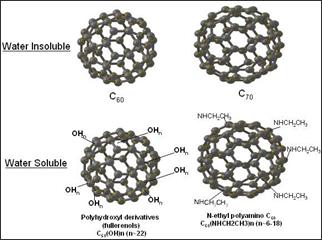Nanotechnology is the creation of useful, functional materials, devices, and systems through controlling and manipulating matter at the molecular level. It is a multidisciplinary field undergoing exponential growth with broad applications among all pisions of science. Fullerenes are a form of carbon nanomaterial that can be functionalized and derivatized with a wide array of molecules that allow them to be used for medical and healthcare applications. Given their unique structure and properties, these carbon-based compounds are being investigated as a new and/or improved way to diagnose, monitor and treat certain medical conditions.
Nanotechnology is the creation of useful, functional materials, devices, and systems through controlling and manipulating matter at the molecular level. It is a multidisciplinary field undergoing exponential growth with broad applications among all pisions of science. Fullerenes are a form of carbon nanomaterial that can be functionalized and derivatized with a wide array of molecules that allow them to be used for medical and healthcare applications. Given their unique structure and properties, these carbon-based compounds are being investigated as a new and/or improved way to diagnose, monitor and treat certain medical conditions.
Luna nanoWorks, located in Danville, Virginia, is manufacturing and developing proprietary fullerene derivatives for use in diagnostics and therapeutics. Luna’s exclusive TRIMETASPHERE® carbon nanomaterial (Figure 1) has the unique capability of carrying up to three functional metal atoms. Trimetasphere derivatives are being investigated for use in magnetic resonance imaging (MRI) as safer contrast media, improving diagnosis and treatment of a range of diseases, including two new techniques: atherosclerotic plaque detection and improved visualization of neoplastic brain disorders.
Fullerenes and Trimetaspheres

Fullerenes are a relatively new class of nanomaterials that represent a third form of carbon (e.g. diamond and graphite) and are spherical in shape – like a soccer ball. The most common fullerene sphere, called a “Buckyball,” contains 60 carbon atoms bound by single and double bonds that form a three-dimensional geodesic spheroidal crystal.(1) For these “empty cages,” 60 or 70 carbon molecules are arranged in a cage structure and are water insoluble unless derivatized with hydrophillic compounds (Figure 2). The fullerene family has very appealing properties which can be exploited alone or through the addition of atoms within the cage or by the addition of surface chemistry.
There are many identified possibilities for using these molecules in developing new drugs or improving upon current drugs. For example, the compounds can be used for specific targeting of cells and locations within the body after intravenous or subcutaneous injection.(2) Likewise, certain fullerenes, such as the Trimetasphere, contain metallic ions which help increase image quality. And, since these metals are captured within the cabon cage, release into the body is not a pathway for these toxins – the cage carries the metal throughout elimination.(6) Given the plethora of capabilities and options that fullerenes and Trimetaspheres bring to the field of nanomedicine, it is not surprising the effect it is having on medical research and drug delivery science.(2;7;8)
Fullerenes for Medical Diagnostics
In today’s contrast agents, the Gd is formulated in a chelate to prevent toxicity. The chelate agent is designed to be in the body for a short period of time and is cleansed through renal elimination. However, in kidney disease, the cleansing system slows down, which can allow the chelate and the Gd to separate – exposing the patient to the toxic metal. The new Trimetasphere-based agent completely encapsulates the Gd so the toxic metal molecules do not escape.
Trimetaspheres are more sensitive MRI contrast agents when measuring relaxivity and the benefits for improving MRI sensitivity are numerous. Coupled with cell-targeting technology, improving relaxivity can enhance detectability of disease conditions, opening the application of MRI to new areas of medicine that were previously beyond current imaging capability. Additionally, future Trimetasphere-based contrast agents can allow for the design and production of smaller-scale, portable MRI systems.
Using Trimetasphere derivatives as new MRI contrast agents may provide physicians new ways to detect atherosclerotic plaque buildup in blood vessel walls. These targeted compounds are being developed to provide images of plaque buildup in the arterial walls of patients with coronary artery disease (CAD). This would allow for earlier detection, providing practitioners and their patients preemptive information before a myocardial infarction or stroke event. Currently, CAD is most-commonly diagnosed through an invasive procedure known as cardiac catheterization angiography.
Fullerenes for Medical Therapeutics
The anti-inflammatory properties of Luna’s new fullerene compounds provide a host of opportunities for advancing medical treatments. Fullerenes are exceptional free radical scavengers, or antioxidants. They can intercept free radicals and neutralize them before they cause cellular harm for many diseases:
Allergy Mast cells (MC) are found in most tissues throughout the body and have traditionally been associated with initiating and propagating the allergic response. Fullerene derivatives are being investigated to inhibit diseases that are critically affected by MC responses. In simplistic terms, the noxious mediators released from MC when a person encounters something he/she is allergic to causes the familiar symptoms associated with allergic reactions. These symptoms range from annoying “hay fever” to life–threatening anaphylactic reactions leading to death. Indeed, most allergy medications are aimed at neutralizing (anti-histamines, H1-receptor blockers) or preventing MC responses. Fullerene derivatives may be capable of blocking this process and, unlike current medications, prevent the allergy reaction before it has a chance to proceed.(11)
Asthma There is substantial evidence that certain forms of asthma are critically dependent on MC; indeed asthmatic attacks are often triggered by common allergens such as cat dander, pollen, etc. The underlying cause of these asthmatic attacks is due to MC mediator release. Under investigation are fullerenes to prevent MC activation in the lung so an asthma attack does not occur.
Arthritis Mast cells play a critical role in the onset of arthritis.(12) Thus, as part of our overall strategy for designing fullerenes that interrupt MC-associated diseases, focus is also on investigating the effects they have on preventing arthritis.
Toxicity considerations for fullerenes
Given the relative infancy of the nanomedical field, especially when you consider the area of carbon-based nanomaterials, the studies examining the toxicity of fullerenes on human systems are still emerging and the subject of much debate.(13;14) For consideration, studies using well-characterized, non-aggregated, single-species fullerenes for in-vitro and in-vivo assays suggest fullerenes are not toxic at physiologically relevant doses. Obviously, all technology discussed within will be subject to the FDA approval process and much data will be forthcoming.
Conclusion
With these new chemical entities, the practice of medicine now has the option of molecular therapies requiring next-generation diagnostics and therapeutics. The product development efforts for Luna’s exclusive fullerene derivatives are focused on the synthesis of a portfolio of nanomedicines aimed at targeting disease and improving diagnostic imaging.
References
- Kroto HW, Allef AW, Balm SP. Buckminsterfullerene. Chem.Rev. 91, 1213-35. 1991.Ref Type: Generic
- Moghimi SM, Hunter AC, Murray JC. Nanomedicine: current status and future prospects. FASEB J 2005; (3):311-30.
- Allen TM, Cullis PR. Drug delivery systems: entering the mainstream. Science 2004; %19;303(5665):1818-22.
- Moghimi SM, Hunter AC, Murray JC. Long-circulating and target-specific nanoparticles: theory to practice. Pharmacol Rev 2001; 53(2):283-318.
- Sahoo SK, Labhasetwar V. Nanotech approaches to drug delivery and imaging. Drug Discov Today 2003;8(24):1112-20.
- S, Fowler PW, Heine T, Duchamp JC, Rice G, Glass T et al. A stable non-classical metallofullerene family. Nature 2000; 408(6811):427-8.
- Bianco A, Kostarelos K, Prato M. Applications of carbon nanotubes in drug delivery. Curr Opin Chem Biol 2005;9(6):674-9.
- Emerich DF, Thanos CG. Nanotechnology and medicine. Expert Opin Biol Ther 2003; 3(4):655-63.
- Marckmann P, Skov L, Rossen K, Thomsen HS. Clinical manifestation of gadodiamide-related nephrogenic systemic fibrosis. Clin Nephrol 2008; 69(3):161-8.
- Marckmann P, Skov L, Rossen K, Dupont A, Damholt MB, Heaf JG et al. Nephrogenic systemic fibrosis: suspected causative role of gadodiamide used for contrast-enhanced magnetic resonance imaging. J Am Soc Nephrol 2006; 17(9):2359-62.
- Ryan JJ, Bateman HR, Stover A, Gomez G, Norton SK, Zhao W et al. Fullerene nanomaterials inhibit the allergic response. J Immunol 2007; 179(1):665-72.
- Nigrovic PA, Lee DM. Mast cells in inflammatory arthritis. Arthritis Res Ther 2005; 7(1):1-11.
- Nel A, Xia T, Madler L, Li N. Toxic potential of materials at the nanolevel. Science 2006; 311(5761):622-7.
- Maynard AD, Aitken RJ, Butz T, Colvin V, Donaldson K, Oberdorster G et al. Safe handling of nanotechnology. Nature 2006; 444(7117):267-9.
















